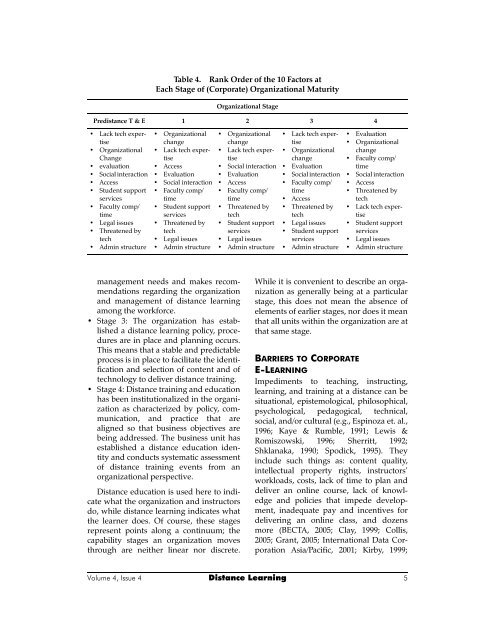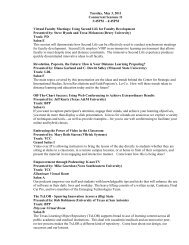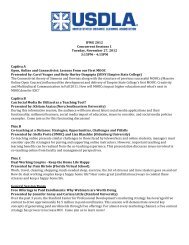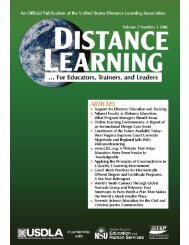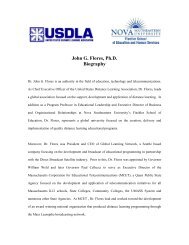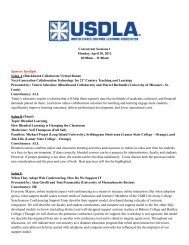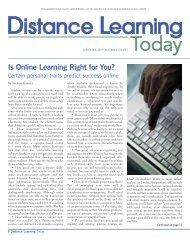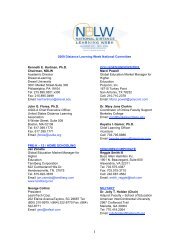United States Distance Learning Association
United States Distance Learning Association
United States Distance Learning Association
- No tags were found...
You also want an ePaper? Increase the reach of your titles
YUMPU automatically turns print PDFs into web optimized ePapers that Google loves.
Table 4. Rank Order of the 10 Factors at<br />
Each Stage of (Corporate) Organizational Maturity<br />
Organizational Stage<br />
Predistance T & E 1 2 3 4<br />
• Lack tech expertise<br />
• Organizational<br />
Change<br />
• evaluation<br />
• Social interaction<br />
• Access<br />
• Student support<br />
services<br />
• Faculty comp/<br />
time<br />
• Legal issues<br />
• Threatened by<br />
tech<br />
• Admin structure<br />
• Organizational<br />
change<br />
• Lack tech expertise<br />
• Access<br />
• Evaluation<br />
• Social interaction<br />
• Faculty comp/<br />
time<br />
• Student support<br />
services<br />
• Threatened by<br />
tech<br />
• Legal issues<br />
• Admin structure<br />
• Organizational<br />
change<br />
• Lack tech expertise<br />
• Social interaction<br />
• Evaluation<br />
• Access<br />
• Faculty comp/<br />
time<br />
• Threatened by<br />
tech<br />
• Student support<br />
services<br />
• Legal issues<br />
• Admin structure<br />
• Lack tech expertise<br />
• Organizational<br />
change<br />
• Evaluation<br />
• Social interaction<br />
• Faculty comp/<br />
time<br />
• Access<br />
• Threatened by<br />
tech<br />
• Legal issues<br />
• Student support<br />
services<br />
• Admin structure<br />
• Evaluation<br />
• Organizational<br />
change<br />
• Faculty comp/<br />
time<br />
• Social interaction<br />
• Access<br />
• Threatened by<br />
tech<br />
• Lack tech expertise<br />
• Student support<br />
services<br />
• Legal issues<br />
• Admin structure<br />
management needs and makes recommendations<br />
regarding the organization<br />
and management of distance learning<br />
among the workforce.<br />
• Stage 3: The organization has established<br />
a distance learning policy, procedures<br />
are in place and planning occurs.<br />
This means that a stable and predictable<br />
process is in place to facilitate the identification<br />
and selection of content and of<br />
technology to deliver distance training.<br />
• Stage 4: <strong>Distance</strong> training and education<br />
has been institutionalized in the organization<br />
as characterized by policy, communication,<br />
and practice that are<br />
aligned so that business objectives are<br />
being addressed. The business unit has<br />
established a distance education identity<br />
and conducts systematic assessment<br />
of distance training events from an<br />
organizational perspective.<br />
<strong>Distance</strong> education is used here to indicate<br />
what the organization and instructors<br />
do, while distance learning indicates what<br />
the learner does. Of course, these stages<br />
represent points along a continuum; the<br />
capability stages an organization moves<br />
through are neither linear nor discrete.<br />
While it is convenient to describe an organization<br />
as generally being at a particular<br />
stage, this does not mean the absence of<br />
elements of earlier stages, nor does it mean<br />
that all units within the organization are at<br />
that same stage.<br />
BARRIERS TO CORPORATE<br />
E-LEARNING<br />
Impediments to teaching, instructing,<br />
learning, and training at a distance can be<br />
situational, epistemological, philosophical,<br />
psychological, pedagogical, technical,<br />
social, and/or cultural (e.g., Espinoza et. al.,<br />
1996; Kaye & Rumble, 1991; Lewis &<br />
Romiszowski, 1996; Sherritt, 1992;<br />
Shklanaka, 1990; Spodick, 1995). They<br />
include such things as: content quality,<br />
intellectual property rights, instructors’<br />
workloads, costs, lack of time to plan and<br />
deliver an online course, lack of knowledge<br />
and policies that impede development,<br />
inadequate pay and incentives for<br />
delivering an online class, and dozens<br />
more (BECTA, 2005; Clay, 1999; Collis,<br />
2005; Grant, 2005; International Data Corporation<br />
Asia/Pacific, 2001; Kirby, 1999;<br />
Volume 4, Issue 4 <strong>Distance</strong> <strong>Learning</strong> 5


